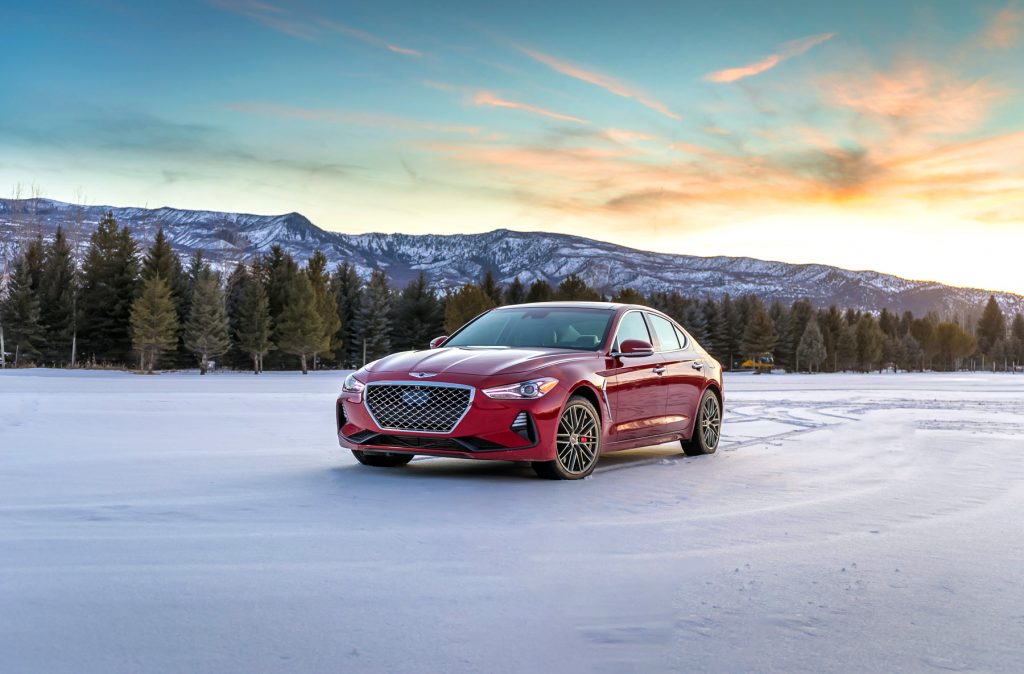Test Drive: 2019 Genesis G70 in Aspen
Plenty of control and some side-sliding fun in the new sedan

It’s early morning and we’re slicing through the Rocky Mountains in a 2019 Genesis G70, rolling toward the track at 10,000 feet elevation. Fittingly for this time of year, conditions on the snowy test track will be much like spring skiing; the icy hard-pack snow softening under the sun as the day goes. But at the moment, the slick, low-friction surface is perfect for evaluating the work engineers have put into the G70’s all-wheel-drive system.
While Genesis is the upstart, upmarket brand created by Hyundai, the G70 has quickly and firmly established itself as a dynamic wonder, a car that can handle as well as the competition—with the engineering side lead by Albert Biermann, the longtime former head engineer of BMW M—and offers a compelling package and alluring design, to boot. But today is a bit special, as we get the opportunity to evaluate the technical prowess of the G70 in the toughest of conditions: ice and snow.

After getting comfortable in the cabin, and admiring the eye-catching quilting of the seats and door panels, we do a couple of initial laps to gain familiarity with the course. Soon, we’re ready to test the 3.3-liter, 365 horsepower, twin-turbo G70 and our skills, lapping the track at speed, while attempting to maintain control under the icy conditions. The G70’s all-wheel-drive system is borrowed from its parent company and was originally created by Magna Powertrain. It works by channeling power between the front and rear axle and can channel up to 90% of power to the rear wheels, creating the feeling of a rear-wheel drive car, which is dynamically desirable.

While some systems use torque vectoring—sending power to the needed wheel to help push out of a corner, for example—the Genesis system employs the brakes to scrub speed from a wheel, effectively creating a helpful power imbalance. It’s a clever system on paper, but on the track, we’re flying at speed, turning aggressively into corners, and somehow driving as if we were almost on asphalt. Only occasionally is there a small slide before the G70’s algorithms kick in, correcting and helping us to maintain control. Given the conditions, the performance of the system (along with proper winter tires) is remarkable—and confidence-inspiring.

The next test is turning systems “half-off,” which means driver input and control comes a little more into focus, but if the car senses you may lose control, it steps in to help maintain stability. Accelerating on a long straight section, we’re able to take turns at high speeds, the tail kicking out just a little, and an effective counter-steer keeps the car moving fluidly across the track.

The last test is perhaps the most rewarding, the most fun. With all systems off, driver ability is most crucial. Here, we’re sawing at the wheel, snow spraying behind us as we slide into corners, correcting and counter-steering to maintain control.

While the drifting brings the wide smiles, it also emphasizes just how much work is actually being done by the G70 when the electronic stability control is on. For people that live in cold weather environments, that sort of safety and control is absolutely necessary, and the G70 delivers here. And should you find yourself in an empty, snowy field, simply holding down a button means you’re seconds away from a little side-sliding fun.
Images courtesy of Bruce Benedict for Genesis












